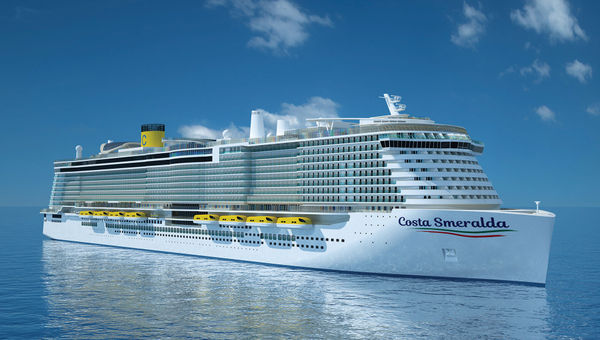It is said that a rising tide lifts all boats. The maxim applies to cruise ships, as well; a surging economy over the past few years has lifted ship construction to unprecedented levels.
In 2019, nearly two dozen ships are scheduled to be delivered to an ocean cruise industry that already operates more than 300 vessels worldwide. But two types of ships are more popular than others.
Increasingly, the order book looks like a barbell with a lot of big ships at one end, a lot of small ships at the other and very little in between. The bulk of the 22 ships scheduled for delivery next year are either under 530 passengers or over 3,000. Only two fall into the middle ground: the Viking Jupiter, another in a series of 930-passenger ships ordered by Viking Ocean Cruises, and the Spirit of Discovery, a 972-passenger ship ordered by U.K. operator Saga Cruises.
The trend toward gargantuan ships has been underway for awhile, but the swarm of small ships is somewhat new. No fewer than 10 ships are set to be delivered next year for expedition cruising, which is breaking out of its niche to become one of the hottest trends since river cruising took off a dozen years ago. Operators range from established names such as Hurtigruten and Celebrity Cruises, which is building a single-destination ship for the Galapagos, to relatively unknown names such as Oceanwide Expeditions.
Two companies, Germany's Hapag-Lloyd Cruises and the French line Ponant, each plan to take delivery of two expedition ships next year. Those four ships combined will carry fewer than 1,000 passengers.
Meanwhile, in the luxury segment, Ritz-Carlton, a big name in land-based hospitality, will make its cruise debut with the highly anticipated Azora. The 298-passenger ship being built for the Ritz-Carlton Yacht Collection is scheduled to be delivered in November and arrive in Fort Lauderdale in time for the 2020 Super Bowl in Miami.
Aiding the trend toward multiple small ships is their relatively modest cost. While the biggest ship due next year, Costa Cruises' 5,000-passenger Costa Smeralda, is budgeted at an even $1 billion, the Azora will cost about a fifth of that, and the 100-passenger Celebrity Flora will cost only $60 million.
The expedition fleet is mostly built at lesser-known yards, such as De Hoop in the Netherlands or Vard in Norway, which don't have the long backlogs of the big yards and can therefore deliver more quickly.
On the other end of the scale, big ships of more than 3,000 passengers are coming for Royal Caribbean International, Norwegian Cruise Line, Carnival Cruise Line and Princess Cruises. Costa Cruises and MSC Cruises are getting two ships each with capacity for more than 4,000 passengers, fed in part by a rivalry in China.

A rendering of the Costa Smeralda, the biggest ship due for delivery in 2019.
"This market is a global priority, and we are committed to serving it with our very best ships and products," MSC Cruises CEO Gianni Onorato said in announcing the MSC Bellissima's deployment to Asia in the spring of 2020. The 4,500-passenger Bellissima, due in March 2019, will sail initially in the Mediterranean.
Meanwhile, Viking has the midsize segment mostly to itself in 2019, as it marches toward a goal of 16
930-passenger ships by 2027.
Bowing to the environment
A second trend likely to accelerate in 2019 is the increasing emphasis on sustainability and environmental best practices.
The wave of operators eliminating certain single-use plastics on their ships, such as straws, became a tsunami in 2018, and in 2019 small-ship operators are taking aim at the plastic water bottle by distributing aluminum bottles to guests and providing water-filling stations.
Larger operators say it will take time to meet the requirements of public health regulations regarding widespread use of filling stations but that they're working on the concept as a midrange goal.
"There are things we are exploring there, but we're definitely in the exploration phase," said Frits van der Werff, vice president of food and beverage at Holland America Line.
Propulsion is another area that will be in transition in 2019. The Costa Smeralda will be the second large cruise ship, after this year's AidaNova, to be powered entirely by liquefied natural gas.
Also scheduled to be delivered in 2019 is a hybrid Hurtigruten expedition ship that will have the ability to run for 30 to 45 minutes on battery power. The 530-passenger Roald Amundsen will be the first cruise ship with that capability, one that Hurtigruten CEO Daniel Skjeldam wanted for its reduced air emissions.
All of Hurtigruten's ships also run on light fuel oil as opposed to more polluting heavy fuel oil, or bunker fuel. Indeed, there's an incipient movement to phase out the use of bunker fuel in cruise ships.
"I think the financial communities will be much more focused on this going forward," Skjeldam said. "We see that in Norway. The finance institutions that are financing us are focusing on it. The owners ask us. I think the shareholders will focus on this going forward."
In the short term, cruise lines are using scrubbers to remove sulfur dioxide and nitrous oxide from exhaust. All of the large oil-fueled ships to be delivered in 2019 will use the technology.